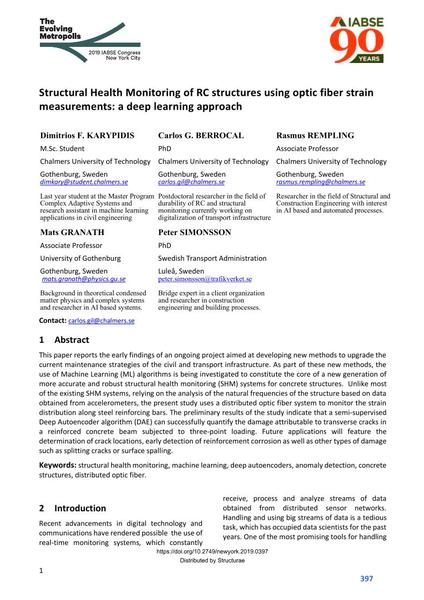Structural Health Monitoring of RC structures using optic fiber strain measurements: a deep learning approach

|
|
|||||||||||
Détails bibliographiques
| Auteur(s): |
Dimitrios F. Karypidis
(Chalmers University of Technology)
Carlos G. Berrocal Rasmus Rempling Mats Granath (University of Gothenburg) Peter Simonsson (Swedish Transport Administration) |
||||
|---|---|---|---|---|---|
| Médium: | papier de conférence | ||||
| Langue(s): | anglais | ||||
| Conférence: | IABSE Congress: The Evolving Metropolis, New York, NY, USA, 4-6 September 2019 | ||||
| Publié dans: | The Evolving Metropolis | ||||
|
|||||
| Page(s): | 397-402 | ||||
| Nombre total de pages (du PDF): | 6 | ||||
| DOI: | 10.2749/newyork.2019.0397 | ||||
| Abstrait: |
This paper reports the early findings of an ongoing project aimed at developing new methods to upgrade the current maintenance strategies of the civil and transport infrastructure. As part of these new methods, the use of Machine Learning (ML) algorithms is being investigated to constitute the core of a new generation of more accurate and robust structural health monitoring (SHM) systems for concrete structures. Unlike most of the existing SHM systems, relying on the analysis of the natural frequencies of the structure based on data obtained from accelerometers, the present study uses a distributed optic fiber system to monitor the strain distribution along steel reinforcing bars. The preliminary results of the study indicate that a semi-supervised Deep Autoencoder algorithm (DAE) can successfully quantify the damage attributable to transverse cracks in a reinforced concrete beam subjected to three-point loading. Future applications will feature the determination of crack locations, early detection of reinforcement corrosion as well as other types of damage such as splitting cracks or surface spalling. |
||||
| Mots-clé: |
structures en béton
|
||||
